In 2020, a rare manuscript from an 18th-century Antwerp dyer was donated to the Museum of Industry in Ghent. This manuscript, compiled between 1778 and 1802, offers a unique glimpse into historical dyeing techniques and insights into the social, economic, and operational realities of a local dyer working in the Verversrui in Antwerp. Through this unique artifact, we aim to reconstruct historical dyeing processes, reproduce the colors, and analyze the context in which these practices emerged.
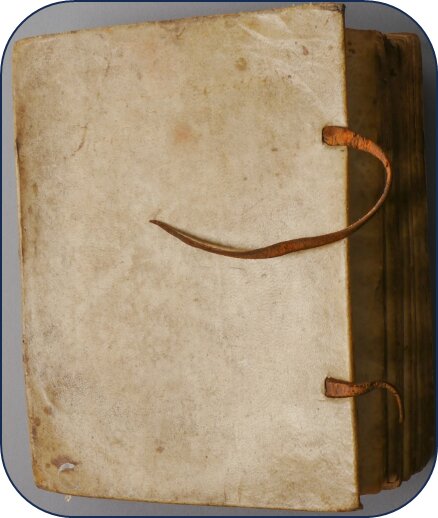
Cover of the dyer’s manuscript
Reconstructing the Historical Context
This manuscript was created during a transitional period in the Southern Netherlands, characterized by the shift from Austrian rule to the influence of the French Revolution. This era (1778–1802) was marked by both economic growth and subsequent instability, as new French trade practices disrupted established markets. Throughout time the Verversrui hosted many dyeing enterprises of different importance and size. This specific manual, based on the analysis of the contents of the manuscript, was produced by one of the smaller enterprises that catered mostly for the middle class. This was determined based on the accounting notes, which confronted with other similar artifacts showed us accounts 20 to 40 times smaller than the ones produced from bigger enterprises we have accounts of the same period. Furthermore, the manuscript belonged to a wool diner who specialized in the production of red tones, as about 70% of the recipes contain red dyestuff and almost 90% of the recipes are applied on wool. Further enriching the manuscript are the 110 samples which are attached to many of the recipes contained in the 160 pages of the manuscript. These original, well-preserved samples are testimony of the skill of the dyer and allow us to directly evaluate and confront them with the recipes they were supposedly produced with and with the reconstructions that were made based on those recipes.
Understanding the Manuscript’s Creation and Purpose
In the 17th and 18th centuries, the amount of available knowledge increased exponentially, granting a public of specialized craftsmen but also to a growing amount of amateurs access to knowledge that until one century prior would have been unthinkable. The result of this growing market is the diversification of the type of manuals that were produced. Some remained practical and addressed to an expert public, others were explicitly written for amateurs and often contained information about an array of disciplines. Out of this evolution, the question arises concerning the nature of the manuscript, evaluating if this was one produced purely as a keep safe of knowledge, or as a practical tool for day-to-day use within a dyeing enterprise.
The answer to this question was given through the analysis of the contents and the elements left by the compiling author. There are no signs in the manuscript showing an intention to publish, also, many pages show adaptations and improvements of the content together with the signs of their practical application. These elements make this manuscript noteworthy, it is not a “finished product” and the draft-like feeling given by this note and improvement system, allows us to have an in-depth view of the taught and procedures behind the compiling of the manuscript. The writer tested the recipes, notes on the side, directly on the text, or by pinning notes, his remarks, and interpretations of said recipes. Sometimes consideration about the quality of the dyed product, possible problems, of alternative materials that could be utilized. Additionally, there is a clear relation between the recipes and the accounting notes, an example hereof is the listing of the goods dyed in one specific vat, accompanied by the prices that they fetched once sold.
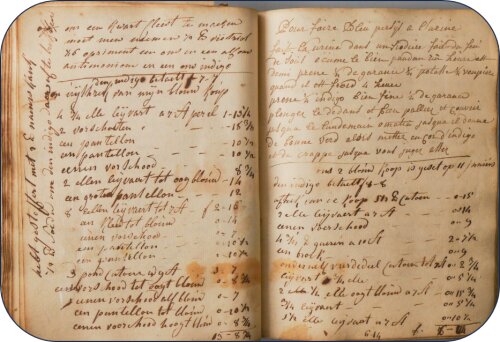
pp.72-73, Blue dyed wares pricing, an example of accounting notes
Interpreting and Reproducing Dye Recipes
The recipes of the manuscript are not presented following a coherent pattern or through a clear structure. Different styles and approaches to knowledge are present a the same time. One first distinction was made a the hand of the length of the recipes, some are very brief and summary, just reporting basic indications on the dyeing procedures. Others are extensive and detailed spanning across multiple pages. A second distinction was made at the hand of the utilized language, recurring grammatical structures and use of words have been found in part of the recipes, which together with the use of the first person (I did, I took…) forms the cluster which was determined being the recipes from the personal experience of the dyer. The second group is the one comprehending recipes that seem to have been copied from other sources. These recipes are generally better structured and comprehend words that do not recur in other recipes. Additionally, they are mostly addressed to a second person (you shall, you will…). Another interesting element is that both kinds of recipes often show signs of re-elaboration and improvement throughout time. As mentioned, notes were added or changes were directly applied to the recipes to improve the results. This element adds a further layer of comprehension of the practice of the dyer, and onto how knowledge evolved in time.
The reproduction of the recipes is another fundamental step in the interpretation of the manuscript. Relevant recipes were selected based on different criteria to create a corpus of reference material. Some of the criteria were completeness, clarity, complexity, and ones containing variations or notes, to better understand the impact thereof. Also, the selected recipes are for the most part ones which were paired to a colored sample, as this grants us the possibility of confronting the reproduction with the original results.
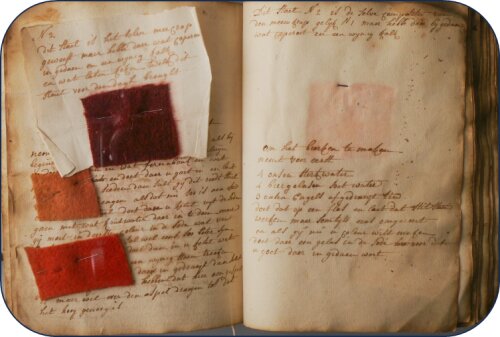
pp. 1- 2 ‘To dye all sorts of colors’ and ‘To dye pure madder red’, with results of the reconstructed samples on the right
Technical Analysis of Historical and Reproduced Samples
The final phase will involve a comparative analysis of the manuscript’s historical samples and the modern reproductions previously created. Through spectroscopic and microscopic analysis, as well as aging, we aim to assess the color consistency, chemical composition, and qualities of the dyes. This analysis will help identify the materials and mordants originally used and the effectiveness of these traditional techniques. By comparing historical and reproduced samples, we can evaluate the accuracy of our recreations and gain a deeper understanding of the challenges and nuances faced by historical dyers.
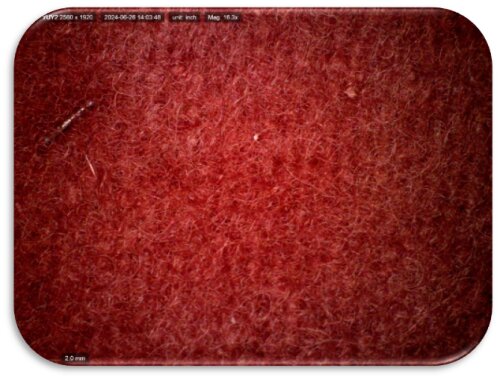
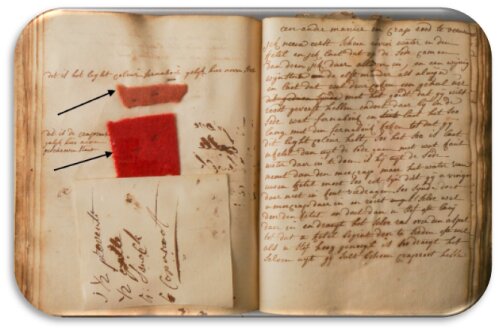
pp. 47 – sample 42 Detail of red dyed sample (top) from recipe ‘Another way to dye madder red’
Contact
Key Publications
Lupatini, E.; Ortega Saez, N.An Unknown 18th-Century FlemishDyers Manuscript from Antwerp(1778–1802). Heritage 2024, 7, 2458–2476. https://doi.org/10.3390/heritage7050117.